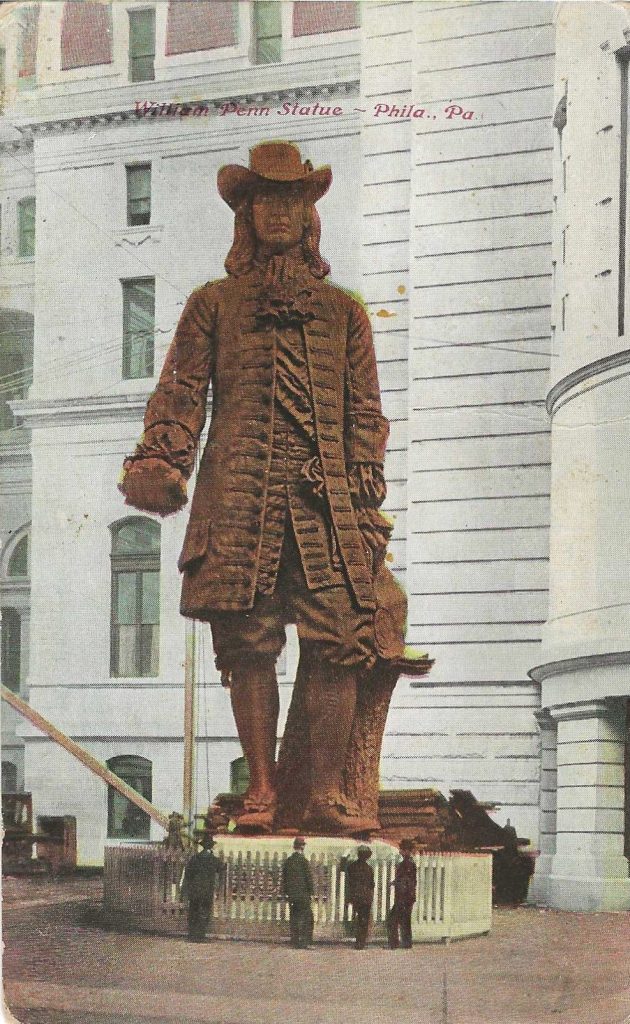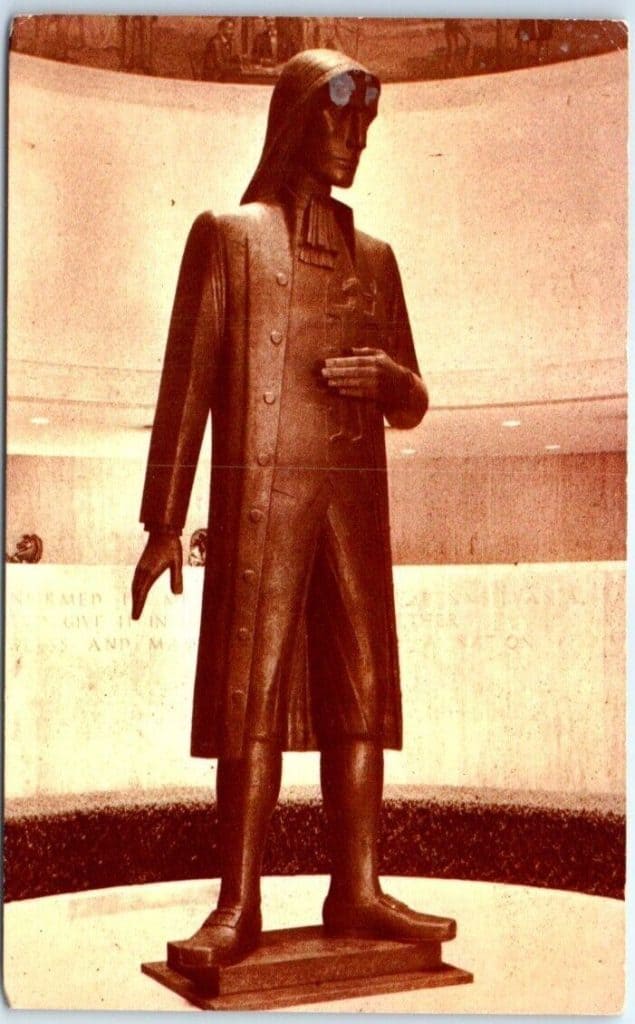
Nearly thirty years ago, in the Sunday Philadelphia Inquirer of October 9,1994, local beat reporter Richard Jones wrote in his weekly column, The Scene, about a “collectibles” show in Atlantic City to be held next weekend. I was already an accomplished collector in the early ‘90s but knew nothing about that show. As I researched the featured card with this essay using a newspaper archive, I was surprised to see the exact same postcard in Jones’s article, as an example of what would be available in Atlantic City.
The William Penn Statue is the pride of Philadelphia and one of Philly’s most popular landmarks. It may be the most photographed item in Philadelphia, with the single exception of the Liberty Bell. The sculptor, Alexander Milne Calder (1846-1923) named his colossus William Penn, which is not surprising, yet quite appropriate.
Calder cast the pieces circa 1890 and completed its construction in 1892. After being transported to the city hall at Broad and Market Streets, it waited in pieces until the morning of Wednesday November 18, 1894. With thousands of spectators present, the steel framework and 53,000 pounds of bronze plates were hoisted to the top of the City Hall Tower and assembled into the 37-foot-tall statue. The work was designed without thought of orientation, but someone decided it should face Penn Treaty Park.
Calder himself later fussed about the placement. He wanted the statue to face south so that the statue’s “features” could be seen plainly from a distance. A worthy complaint since the statue as it stands, facing the northeast, leaves the face in the shadows of its own head.
[Not surprising was that neither of the major newspapers covered the event on their front pages. “Old Billy Penn” took second place in newsworthiness that day. The front pages of the Philadelphia Inquirer and the Philadelphia Times were dedicated – almost in their entirety – to the upcoming Penn vs. Harvard football game.]
Notice in the picture the relative size of the statue compared to the four men (boys) standing outside the fence.
***
The William Penn statue has never been entirely immune to criticism. The direction it faces, discussed above, may have been the beginning and to date it has not ended.
Quite recently (January 2024) Mark Levy, a politics and statehouse reporter for the Associated Press, based in Harrisburg wrote: The National Park Service, which oversees the management of City Hall, has attempted to remove the statue in response to concerns that it remains a symbol of racism and colonialism. In the case of Penn, many argue that William Penn, as the founder of Pennsylvania must remain status quo, and they mock the idea of renaming the state Sylvania or Billieswoods.
Be clear that this movement has concerned itself with the statue of Penn that they want removed is a copy of the Calder statue that was placed at the center of the city hall complex in 1901. The greater concern is that when one “goes” the other will soon “follow.”
The pushback has in some theatres been quite intense. The loudest voices are those who believe that the statue should remain as a part of the city’s history.
Mr. Levy concludes with, Ultimately, the fate of the William Penn statue remains uncertain as the debate continues to unfold. This may be one that the Revisionists won’t win.

Sadly, the debate also continues in the political discourse in Washington. And as we have seen recently there are very few winners in Washington. Which in some instances has fostered the movements to “erase” people and events by removing statues and monuments. Those who see statues as symbols of unpleasant times have gone far afield to assure that too much press is given where and when larger problems loom. Those same people will argue that William Penn, as the founder of Pennsylvania, played a significant role in the displacement and mistreatment of indigenous peoples.
No one in the current discussion remembers the facts, therefore historians are expected to weigh in and they will tell us that Penn founded Pennsylvania after King Charles II granted him a charter for over 45,000 square miles of land in 1681.
One historian reminds us that being a Quaker in Penn’s time meant dressing in plain clothes, using plain speech, and worshipping in plain spaces. In fact, Quakers often refused to have gravestones to avoid calling attention to themselves.
In 1718, at age 73, Penn died, back home in England, penniless. He was buried in the Quaker cemetery on the outskirts of Buckinghamshire.
Alexander Milne Calder was the grandfather of Alexander Calder, the sculptor known for his mobiles.
Thank you for the fine article. I have not seen that statue since I was a child; though I have several postcards featuring it. Your article was also a good reminder to try to see historic leaders in their own time and environment.
Great article. Really enjoyed the backstory of this monument/statue. It is somewhat comical to me over what things have become controversial in our “modern” society.